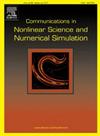四阶抛物问题的无稳定子弱 Galerkin 方法与隐式 θ 方案
IF 3.4
2区 数学
Q1 MATHEMATICS, APPLIED
Communications in Nonlinear Science and Numerical Simulation
Pub Date : 2024-09-16
DOI:10.1016/j.cnsns.2024.108349
引用次数: 0
摘要
在本研究中,我们将θ∈[12,1] 时的隐式θ方案与无稳定器弱伽勒金(SFWG)方法相结合,求解了四阶抛物线问题。提出了半离散和全离散数值方案。具体来说,当θ=1 时,全离散方案是一阶后退欧拉方案;当θ=12 时,全离散方案是二阶 Crank-Nicolson 方案。然后,我们在分析了方案的拟合优度后,确定了 H2 和 L2 规范下误差的最佳收敛阶数。数值实验验证了理论结论。本文章由计算机程序翻译,如有差异,请以英文原文为准。
A stabilizer free weak Galerkin method with implicit θ-schemes for fourth order parabolic problems
In this study, we solve the fourth-order parabolic problem by combining the implicit -schemes in time for with the stabilizer free weak Galerkin (SFWG) method. The semi-discrete and full-discrete numerical schemes are proposed. And specifically, the full-discrete scheme is a first-order backward Euler scheme when , and a second-order Crank–Nicolson scheme for . Then, we determine the optimal convergence orders of the error in the and norms after analyzing the well-posedness of the schemes. The theoretical findings are validated by numerical experiments.
求助全文
通过发布文献求助,成功后即可免费获取论文全文。
去求助
来源期刊

Communications in Nonlinear Science and Numerical Simulation
MATHEMATICS, APPLIED-MATHEMATICS, INTERDISCIPLINARY APPLICATIONS
CiteScore
6.80
自引率
7.70%
发文量
378
审稿时长
78 days
期刊介绍:
The journal publishes original research findings on experimental observation, mathematical modeling, theoretical analysis and numerical simulation, for more accurate description, better prediction or novel application, of nonlinear phenomena in science and engineering. It offers a venue for researchers to make rapid exchange of ideas and techniques in nonlinear science and complexity.
The submission of manuscripts with cross-disciplinary approaches in nonlinear science and complexity is particularly encouraged.
Topics of interest:
Nonlinear differential or delay equations, Lie group analysis and asymptotic methods, Discontinuous systems, Fractals, Fractional calculus and dynamics, Nonlinear effects in quantum mechanics, Nonlinear stochastic processes, Experimental nonlinear science, Time-series and signal analysis, Computational methods and simulations in nonlinear science and engineering, Control of dynamical systems, Synchronization, Lyapunov analysis, High-dimensional chaos and turbulence, Chaos in Hamiltonian systems, Integrable systems and solitons, Collective behavior in many-body systems, Biological physics and networks, Nonlinear mechanical systems, Complex systems and complexity.
No length limitation for contributions is set, but only concisely written manuscripts are published. Brief papers are published on the basis of Rapid Communications. Discussions of previously published papers are welcome.
 求助内容:
求助内容: 应助结果提醒方式:
应助结果提醒方式:


